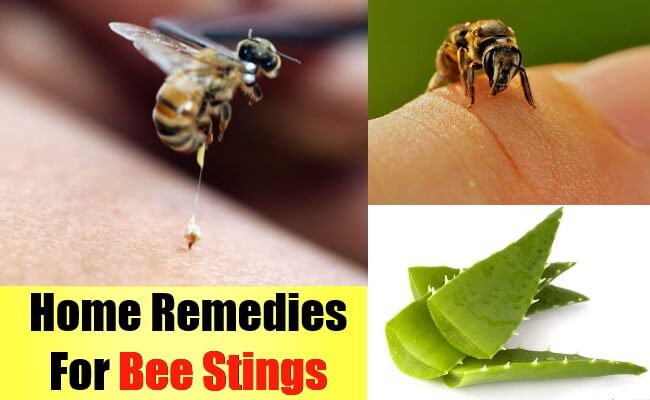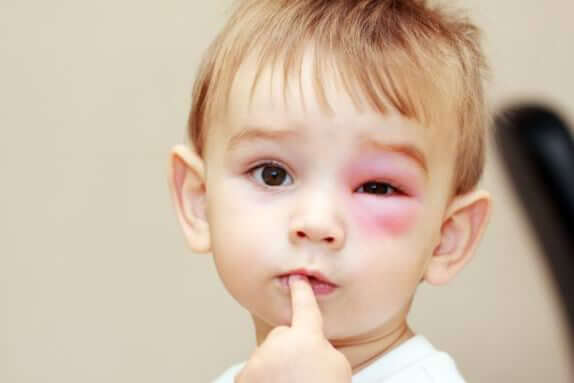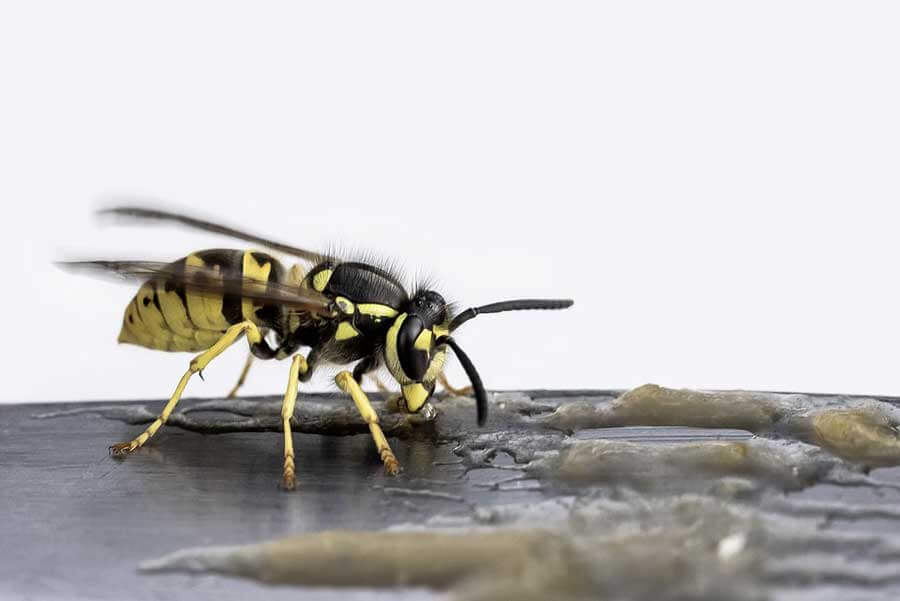A stroll in the park, a walk in the garden, wandering in the backyard with blossoms, butterflies, and bees around you and a sudden jolt, a shooting pain! Sadly you have had a bee sting. This article is all about how to treat a bee sting, so continue reading.
A bee sting is a nuisance that is very common in the outdoor. One simple technique to avoid bee stings is that, when a honey bee comes meandering towards you, sitting still without any movement helps. So, if you were to move your hands and legs to shoo the honey bee away, it is definitely going to give you a sting.
Scientific research also shows that bees only sting when they are threatened by an intruder nearing their hive, loud noise or too much-scented perfumes.

Bee sting treatment depends on the type of the sting and how your body reacts to it. In maximum cases, bee stings are just irritating, and a home treatment is all that’s required to comfort the pain of bee stings. But if you show allergic reactions to bee stings or if you get stung number of times, you may have to go to the Emergency Room.
Table of Contents
Bee Sting Symptoms
The indications and bee sting treatment are largely influenced by the amount of bee venom that has entered your body, whether the stinger is still inside the skin and the sensitivity and reaction of your skin.
Bee stings can create different reactions, ranging from short-term pain and uneasiness to severe allergic reactions. Every time one gets stung, the reactions could vary.
1.Mild reactions
A general bee sting gives a minor or mild reaction. The symptoms of these stings may last for a few hours and will be recovered easily. The symptoms include:
- Immediate, severe burning pain at the sting site
- A red bump and slight swelling at the sting area
2. Moderate reactions
These are a little stronger reaction which includes symptoms that may last for a couple of days and it may take up to a week or so to recover.
- Extreme redness
- Swelling at the sting site that steadily enlarges over the next couple of days
3. Toxic reactions
Bee sting sometimes gives out life-threatening reactions and develop Anaphylaxis.
Signs and symptoms of anaphylaxis may become so severe that one may require going to the emergency room.
- Quick swelling around the eyes, lips, tongue or throat
- Difficulty in breathing
- Wheezing
- Hoarseness
- Itching
- Cramping or severe numbness
- A weak, rapid pulse
- Nausea or vomiting
- diarrhea
- Dizziness or fainting
- A reddish rash like hives
- Stomach cramps
- Loss of consciousness
4. Multiple bee stings
When a bee stings a person, it releases pheromones as a signal to other bees indicating a threat. This attracts the other bees and induces them to sting. Sometimes a person may disrupt a hive or swarm of bees and get multiple stings which accumulate venom. This may bring out a toxic reaction and make quite sick. The Signs and symptoms include:
- Nausea or vomiting
- Diarrhea
- A headache
- A feeling of spinning or vertigo
- Seizures
- Fever
- Wooziness or fainting
Multiple stings can be a medical crisis for small children and older adults. It could be life-threatening for those people suffering from heart or breathing problems.
How to treat a bee sting?

When a bee stings, it leaves its sting on the skin which needs to be removed straight away to prevent infection. Home remedies may be used for minor and moderate bee stings with light redness and swelling without any life-threatening allergic reactions.
1. Squeeze out the sting and apply ice cold water
As soon as the bee stings, look for the stinger at the sting site and scrape it out with the help of a credit card or a similar object. Once the stinger is out, carefully squeeze out the venom. At least till the stinger is out; avoid itching and scratching as it may worsen the case. Instantly apply ice water or soap on to the stung area for 20 minutes. This relieves the pain and swelling in a matter of few hours.
2. Grab a “Base”
A Base counteracts or neutralizes the acidic influx induced by the sting which causes a burning sensation. Make a paste of baking soda or vinegar with water and apply it on the wound for about half an hour. If the baking soda or vinegar is not available some toothpaste may be applied, which also acts as an operative base to counter the acidic sting.
3. Raw potato or onion
Raw potato and onion both have anti-inflammatory properties and have been used conventionally to treat the initial pain of stings where an extreme allergic reaction is not induced.
4. Juice of crushed garlic
Applying the juice of crushed garlic on the area of the sting for around 20 minutes is also known to give positive results.
5. Papaya
Papaya contains effective enzymes that help against inflammation and promotes healing of burns.
6. Honey
Dabbing honey on to the sting area and wrapping it with gauze for about half an hour may prove to be an effective remedy.
7. Mud
Bee stings generally happen when one is outside the home. The ingredients for self-treatment may not be available at the spot. So, sprinkle some mud and water on the sting wound to ward off the initial pain. Add a proper amount of water to spread the mud evenly around the wound area. Rinse it off when you get home and apply an antibiotic cream.
8. Essential oils
Lavender essential oil is an effective neutralizer to the venom. Dabbing a drop or two of the oil gives relief from the sting. It can also relieve the swelling with its strong anti-inflammatory abilities. A bit of coconut oil may be mixed for effective results.
9. Plantain leaf
Juice extracted from plantain leaf may be applied to the sting area as it is a great pain reliever.
10. Aloe Vera
Break off an Aloe Vera leaf and squeeze out the gel. Applying the gel directly onto the wound relieves the pain of the bee sting. It also acts as a soothing agent.
Medical treatment for a bee sting:
When a bee sting or multiple bee stings show signs and symptoms of anaphylaxis-like wooziness, difficulty in breathing and increase in the pulse rate, one may have to go to the emergency room. Even in cases where the bee sting is in the sensitive areas of the nostril, lips, tongue, private areas, abdomen, nipple or armpit one should go to the hospital.
During an anaphylaxis attack, the emergency medical team may perform Cardio Pulmonary Resuscitation (CPR). If breathing stops, medications may be given to reduce body’s allergic reactions; oxygen will be given to support breathing. Medicines to reduce inflammation of your passages and to improve breathing will be given.
Epinephrine auto-injector is an injector with a combined syringe and concealed needle that contains a single dose of medication when injected through a thigh. It has to be used by its expiration date. People suffering from such allergies need to teach their closest people on how to administer the auto-injection.
Bee stings are a common cause of anaphylaxis. If one has experienced serious allergic reactions, the allergist recommends immunotherapy with allergy shots.
How to treat Bee sting swelling?

The bee dies right after giving a sting but the one who is stung may have some redness and swelling for a couple of days. Following remedies may be used to treat the swelling from the bee sting.
- Cold compression with an ice pack or cubes wrapped in a cloth for 15 to 30 minutes depending on the swelling
- Witch hazel extract contains choline, proanthocyanins, saponins, Gallic acid and some oils like carvacrol, hexanol, and eugenol may help in reducing pain and swelling
- Applying a mixture of crushed garlic in hot coconut oil over the sting will reduce the swell
- Applying a paste of marshmallow leaves gives a soothing effect to the stung area and relieves the swelling
- Peppermint leaf oil, with its inflammatory properties, help to reduce pain and swelling
- Applying a paste made of turmeric and water helps to reduce pain and swelling as it contains anti-inflammatory, anti-bacterial and antiseptic properties
Wasp sting treatment
Wasps are generally found in regions where there is warm or temperate climate. Wasps are furnished with a stinger for self-defense. The stinger holds venom that is transferred into the skin during the sting.
Wasp stings are different from bee stings. Bees that can sting only once and the sting come off and stick to the skin but, wasps can sting numerous times during an attack as their stinger stays undamaged and does not get stuck in the skin of the victim. Wasp stings are exceptionally painful and can prove to be deadly if not cured in time.
Symptoms of the wasp sting

Pain, burning sensation, itchiness, redness and slight swelling may be experienced. These symptoms will disappear in a few hours. Other symptoms like nausea, vomiting, fever, dizziness, and headache may be seen.
Medical treatment needs to be undergone if following symptoms occur:
- If the sting is inside nose or mouth which will affect breathing by blocking the air passage
- If there are multiple stings by a single wasp or when stung by several wasps
- Experiencing dizziness, nausea or blurry vision
- When heart rate increases and blood pressure falls
- If swelling or itchiness occurs in body parts that are not stung
- If speech is slurred or difficulty in talking occurs or due to the swelling of the tongue.
- Hives
- Itching
- Swelling and pain at the site of the sting
- Abdominal cramping
- Nausea and vomiting or diarrhea
How to treat a wasp sting
If the complexity of the wasp sting is not severe, it may be cured with some home remedies.
- Use of ice pack or ice cubes on the stung area
- Applying of toothpaste on the wound
- Applying a mixture of baking soda and water
- Vinegar or apple cider vinegar neutralizes the venom and relieves pain and swelling
- Lemon juice with its acidic properties relieves the pain and redness
- Applying crushed garlic with salt and tying with a gauze reduces the pain
- Applying half a slice of onion on the wound cures pain
- Cucumber soothes the redness and relieves pain
- Potato has cooling effects on the wound
- Applying olive oil reduces itchiness and redness
- Calamine lotion gives immediate relief
- Applying Epsom salt with water relieves pain
- Rubbing the petals of the marigold flower on the wound reduces itchiness
- Basil leaves with its anti-bacterial properties cures the pain, swell and itch
- Applying Aloe Vera gel soothes the wound
In case of multiple stings or if the sting gives severe allergic reactions then one may have to go to the emergency room for medical treatment.
The physician will measure and observe the person’s vital signs which include the temperature, pulse rate, pace of breathing, and blood pressure. These symptoms will be treated. The person may also have to undergo:
- Blood test and urine test
- Breathing support with oxygen where a tube is inserted through the mouth into the throat
- In serious cases breathing machine will be fitted
- A chest x-ray will be taken
- ECG -electrocardiogram, for heart tracing
- Intravenous fluids will be given through a vein




























